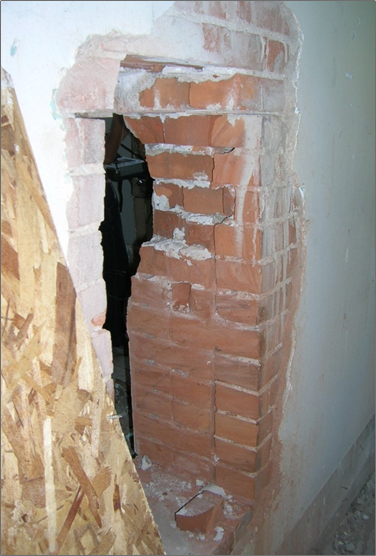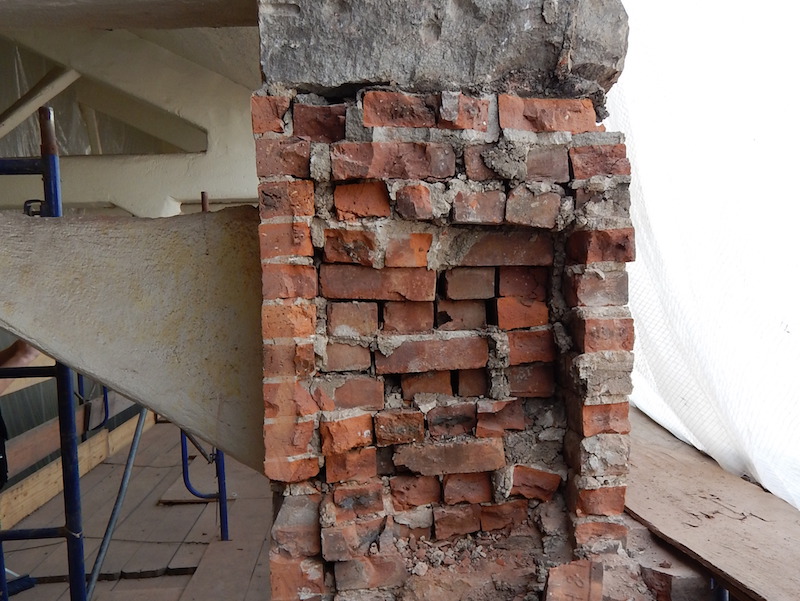Deep Energy Retrofits for Historic Masonry Buildings
Words: Bronzella Cleveland
Words & Photos: Christine A. Subasic, PE, LEED AP
Existing buildings offer the greatest opportunity for achieving energy efficiency and reducing the overall building energy use in the U.S. Buildings constructed before 1980 were built to model energy codes that are vastly less stringentthan current code requirements. As a result, even minorenergy retrofits can yield beneficial results.
Generally, energy retrofits can be categorized as modest retrofits or deep energy retrofits. Modest retrofits are typically simple in scope and relatively quick to implement with modest payback periods. These retrofits may include sealing, caulking, replacing light fixtures, and adjusting HVAC settings. Deep energy retrofits (DER), on the other hand, involve more extensive, costly measures. DERs requires a comprehensive look at whole building energy performance and usually have a longer payback period than more modest retrofits. DERs may be more economical when they occur as part of a major renovation. Planned replacements of major components such as roofing or HVAC systems are opportune moments for DER.
Deep energy retrofits include evaluation and potential upgrading of the entire building envelope (walls, roof, floors), and mechanical and lighting systems. DER may include the introduction of new energy-saving strategies such as daylighting, photovoltaic panels, or natural ventilation. Because DER considersthe performance of the building as a whole, building energy use savings of 45% or more are possible.
Deep Energy Retrofits
Resources
There are a number of resources available for building owners and designers considering a deep energy retrofit on a building. The Department of Energy’s Advanced Energy Retrofit Guides(2011) providesstep by step instructions on things to consider before undertaking a DER. There are Guides available for office buildings, retail buildings, grocery stores, K – 12 schools, and healthcare facilities. ASHRAE Standard 100 Energy Efficiency in Existing Buildings(2018) provides criteria to achieve reduced energy consumption through energy efficiency measures and overall building performance evaluation specifically for existing buildings, while the ASHRAE Advanced Energy Design Guidesseries, though intended primarily for new construction, contain guidance that is applicable to existing buildings. These ASHRAE publications also provide measures based on building use type.
General Recommendations
Recommendations for DER depend on the climate in which the building is located as well as on the building type and other factors. Some measures that are cost-effective in one climate may not be appropriate in another. For this reason, the above-mentioned guides require a whole building performance evaluation to determine the appropriate recommendations. However, generally DER will include consideration of the following strategies:
Lighting:
- Retrofitting interior light fixtures to reduce lighting power density
- Installation of occupancy sensors
- Adding daylighting
- Retrofitting exterior light fixtures to reduce lighting power density
Plug and Process Loads:
- Replacing office and other equipment with more efficient models
- Adding advanced controls to plug and process loads
HVAC:
- Replacing HVAC systems with more efficient designs and/or passive systems such as natural ventilation
- Using controls to only run equipment when needed
Envelope:
- Adding roof insulation
- Adding wall insulation
- Replacing windows and doorswith more energy efficient ones
Renewable energy:
- Adding renewable energy systems
Commissioning:
- Evaluating building performance through building commissioning process
These are just examples of some of the common strategies used and are not a comprehensive list. Some are fairly easy to employ (replacing lighting) and some are quite complex (adding insulation). The design team must carefully evaluate the appropriateness and effectiveness of any retrofit plan based on the building’s climate, location, use, energy efficiency goals,and costs.
Masonry Buildings
Masonry buildings are among the many existing buildings that are candidates for deep energy retrofits.The durability and aesthetic appeal of masonry buildings make them popular choices for adaptive reuse.(Photos1a and 1b)[Photo credit: Christine A. Subasic)However there are unique aspects that must be considered for historic masonry buildings, particularly those constructed with mass (multi-wythe) walls. The Department of Energy has published several papers that provide guidance specifically for retrofitting historic masonry structures (Musunuru and Pettit 2015, Straube et al. 2012).
 Photo 1a: The Cleveland Trust Rotunda
Photo 1a: The Cleveland Trust Rotunda
 Photo 1b: Interior of Cleveland Trust Rotunda, renovated as a grocery store
Photo 1b: Interior of Cleveland Trust Rotunda, renovated as a grocery store
Considerations
Deep energy retrofits often include adding insulation to the walls. For historic masonry buildings, preservation of the exterior appearance is essential, and so insulation can only be added to the interior of the walls. In the case of mass masonry buildings, this must be considered carefully, particularly in cold, wet climates. The potential for damage due to excess moisture is high.
Historic masonry buildings are built very differently from the masonry veneer systems of today. The mass walls of historic buildings are built with multiple wythes of masonry, and the loadbearing walls of these buildings can range from 8 inches to 36 inches or more in thickness. In some cases, the wythes are fairly uniform in nature (Photo 2) and in other cases, they are not (Photo 3). These multi-wythe walls rely on the thermal mass properties of the masonry to moderate temperature swings,and on the heat from the interior of the building to help keep them dry. Air and water vapor move freely in these systems.
 Photo 2: Uniform mass wall. Photo credit Atkinson-Noland & Associates, Consulting Engineers
Photo 2: Uniform mass wall. Photo credit Atkinson-Noland & Associates, Consulting Engineers
 Photo 3: Irregular mass wall. Photo credit Atkinson-Noland & Associates, Consulting Engineers
Photo 3: Irregular mass wall. Photo credit Atkinson-Noland & Associates, Consulting Engineers
Adding interior insulation to a mass masonry wall can lead to problems because the added insulation changes the dew point in the wall system. Care must be taken to ensure condensation does not occur in the masonry. In cold climates,this could lead to freeze-thaw damage of the brick and rotting of wood structural members embedded in the masonry walls such as floor joists. A hygrothermalanalysis should be completed using WUFI (accessed 2018) or similar software. Musunuruand Pettit (2015) provide guidance on important criteria that include “cost and performance, durability, constructability, freeze-thaw degradation risk, air leakage performance, and thermal performance” that must be considered when evaluating the addition of interior insulation.
Deep energy retrofits of mass masonry buildings must include assessmentof the whole building performance. In some cases, after careful evaluation, the decision may be made not to add interior insulation, but instead focus on the roof and mechanical equipment efficiencies, or some other combination of options.
Case Studies
Manyhistoric masonry buildings have successfully completed DER. Some are documented in Straube et al. (2012) and Musunuru and Pettit (2015). Another source for examples of DER is the New Buildings Institute. The Beardmore Building(Deep Energy Savings 2012)is a historic masonry building thatachieved a 66% better than baseline energy performance while maintaining its National Historic Register status.The Joseph Vance Building (Deep Energy Savings 2012) is another. Sites such as BetterBricks.com also provide examples of successful masonry retrofits.
Conclusion
Masonry buildings are great candidates for renovation and adaptive reuse. However, their durability and beauty come with some challenges as well. Deep energy retrofits that often come with renovations can successfully be applied to historic masonry buildings with careful consideration of the unique nature of this type of construction. Deep energy retrofits should consider whole building performance for best results. Additional insulation with mass masonry walls must be analyzed for effects on condensation, particularly when interior insulation is considered. With care and attention to detail, highly efficient buildings are possible.
References
Advanced Energy Retrofit Guides forOffice Buildings(2011). Pacific Northwest National Laboratory and PECI. Washington, DC: Building Technologies Program, U.S. Department of Energy.
ASHRAE 100 (2018).Standard for Energy Efficiency in Existing Buildings, American Society of Heating, Refrigerating and Air-Conditioning Engineers (ASHRAE), Atlanta, GA.
Deep Energy Savings in Existing Buildings Case Study, The Beardmore Building(2012). New Buildings Institute, Washington, DC.
Deep Energy Savings in Existing Buildings Case Study, The Joseph Vance Building(2012). New Buildings Institute, Washington, DC.
Musunuru, S. and Pettit, B. (2015). Measure Guideline: Deep Energy Enclosure Retrofit for Interior Insulation of Masonry Walls. Washington, DC: Building America Program, Office of Energy Efficiency and Renewable Energy, U.S. Department of Energy.
Straube, J.F.; Ueno, K.; Schumacher, C. (2012). Measure Guideline: Internal Insulation of Masonry Walls. Washington, DC: Building America Building Technologies Program, Office of Energy Efficiency and Renewable Energy, U.S. Department of Energy.
WUFI®PC-Program for calculating the coupled heat and moisture transfer in buildings. Fraunhofer Institute for Building Physics. Germany.
About the Author:
Christine A. Subasic is a consulting architectural engineer specializing in masonry and sustainable design. She is a member of the ASHRAE Standard 189.1 Project Committee, ASTM E60 Committee on Sustainability, and President-Elect of The Masonry Society. She can be reached at CSubasicPE@aol.com.